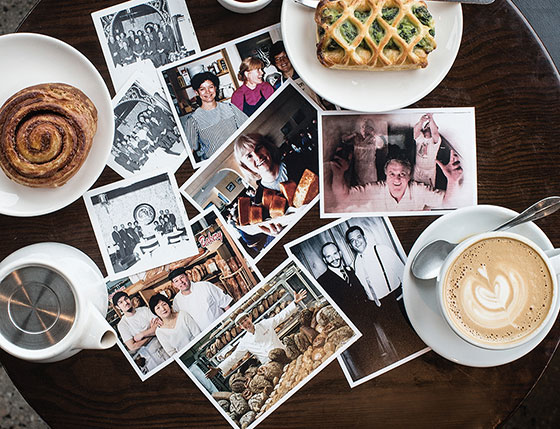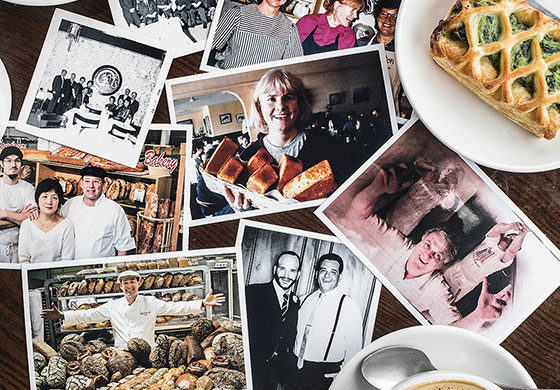Second generation restaurateurs tell their story
by Stuart Adams

When the average lifespan of most Edmonton restaurants is eight years, reaching that mark is a challenge, but surpassing it requires support from a capable second generation.
With a combined age of over 130 years, The Lingnan, Upper Crust Cafe and Tony’s Pizza Palace stand out in Edmonton’s restaurant scene. For starters, not only have they operated for at least a quarter century, but they are being run by the new kids—all in their 30s and 40s.
Menus in all three establishments have changed over the years, but Miles Quon of The Lingnan, Megan Rich of Upper Crust, and Sal and Tony Mazzotta Jr. all had a strong work ethic instilled in them as youngsters in their parents’ restaurants. “I’ve been working here since I was six-years-old, shelling peapods and deveining shrimp— on-the-job family training,” says Quon.
The Lingan
The Lingnan is the granddaddy of the trio and Miles is the third generation of Quons to run the restaurant.
His grandfather opened The Lingnan in 1947, which his father took over in the late ’70s. Although Miles has worked at the restaurant most of his life, he committed to becoming the third operating generation when he finished university in 2005. He believes that The Lingnan is the oldest continually operating Chinese restaurant in Edmonton.
He also believes strong relationships with their customers have carried them through to what will soon be their 70th anniversary. Miles has had customers tell him they remember him as a child. “It’s generation serving generation, and sometimes the fifth generation,” he says.
That relationship paid dividends a few years ago when an appreciative customer brought in an original menu they had saved from the late ’40s. Miles had it framed and put on display, which shows their telephone number: 27203.
In addition to the five-digit telephone number, the fare has evolved over the decades. “It morphed, slowly,” he says, pointing out typical chop sueys, alongside standard North American steaks and soups. “It was all North American Canadian-style Chinese food. Then, Hong Kong people began arriving and we had Chinese chefs who wanted to try other things.”
As clients travelled more, they requested new dishes, and by the ’80s, his father had weeded out the North American food. Today, only two such dishes remain: chicken fingers and French fries.
Miles has introduced a more modern sensibility to the menu, however people do ask for old favourites off old menus. Their staff, many who have been with them since the ’70s, remember those dishes and are happy to make them.
He describes the approach as using traditional techniques, but with local ingredients where practical, and with local customers in mind. “We’re traditional, but we can’t be authentic,” he says, adding that while lard is authentic in China, they don’t use it at the Lingnan. “We use our techniques from China, but adapt the dishes to Edmonton. Our spices are from everywhere—star anise from Viet Nam and chilis from India.”
The end result is a clientele that he says reflects the Canadian mosaic—largely Caucasian, but also with East Indian, First Nations and Lebanese representation.
Upper Crust Cafe
Megan Rich has memories of she and her three sisters working after school when her mother Sheila and original partner Karen Fulton started catering in 1982. They cooked for corporations and law firms in the Rich kitchen. “We’d have to come home every day after school and clean the kitchen,” she says, adding that they all worked high school summers in the restaurant.
Upper Crust Cafe has expanded the restaurant space twice, as well as the kitchen. More than half their business is still catering, and about 70 per cent of their staff is in the kitchen—many of whom have been with them for more than five years.
From her early years, Megan worked on and off at Upper Crust to finance a university stint, before travelling and some work in Spain. Then, in 2000, she entered into the partnership with her mother and Karen’s sister, Barbara Bester. Sheila Rich stills works on the occasional special project and does the catering for pet clients, such as the Players de Novo from the legal community; but at this writing, she and her husband are camping their way across the U.S.
Barbara and Megan oversee the daily operations. “Without really good staff, you can’t do this business,” Megan says, and adds that their three cooks are given the autonomy to bring their respective approaches to the downhome cooking that characterizes the restaurant. “The food hasn’t changed in quality, it’s still all cooked from scratch. We allow the cooks to make changes, they’re so good that we don’t have to micromanage.”
The proximity to the University of Alberta has generated a few unique, university-related experiences. “We’ve put so many people through university,” says Rich, adding that singer KD Lang and actor Paul Gross visit regularly without creating a disturbance among the staff. But the night Margaret Atwood came for dinner, the three English majors serving that night were too paralyzed to attend to the famous writer. Another server had to step in and take care of the Atwood table.
And like the other two restaurants, Upper Crust has created a loyal clientele, that Megan says has not only prompted new dishes to be added to the menu, but old ones have also been returned—such as the vegetarian chili. “We had a lady who stood in our deli and cried,” says Megan. The vegetarian chili was returned to the menu.
Tony’s Pizza Palace
Brothers Sal and Tony Jr. have carried on the tradition that Tony Sr. began in 1986 when he opened at the current location. They view themselves as keepers of the family legacy. Tony’s Pizza Palace recently led the way as Edmonton was named eighth best pizza city in the world in a Condé Nast Traveler magazine readers’ poll in April.
The brothers Mazzotta have obviously kept the pizza tradition alive, but Sal says that where pizza used to be about 90 per cent of their business, it’s now about 65 per cent. “We’ve turned the pizzeria into a restaurant with pizza,” says Tony Jr. “We have Barolos and Amarones and high-end spirits on the list. We like to cater to everyone’s needs, not just serve pizza.”
They have also made other changes, such as taking the restaurant paperless; servers use iPads to take orders. But, like the other second generation operators, the brothers worked in their father’s restaurant at an early age. “From the age of 13, I was coming in to wash dishes and would see people coming and thanking my dad,” says Tony Jr., “It was the satisfaction of feeding people and making them happy that stayed with me.”
They also have had special relationships with their customers—most notably the Oilers and the Eskimos. Tony Jr’s. first Tony’s memory is the Oilers’ 1987 Stanley Cup celebration when he was six. “The place was jammed and I remember my dad flipping pizza.”
So, how important is the legacy? Sal is as adamant about maintaining tradition as he is about pleasing customers and he recognizes how his father was an innovator, adding Italian ingredients to New York-style pizza.
But there are limits. “Don’t ask for pineapple on a pizza,” he says. “We’ll put it on the side, but not on the pizza. We don’t want to sell ourselves short to make a dollar.”
With some regret, he recalls refusing to put pineapple on a pizza for a long-time customer, especially since the person never returned. “I can’t make that for you. My dad would kill me,” he remembers telling the customer—but with an assuredness that indicates the answer would remain the same today.
Today, Tony Mazzotta Sr. is comfortable in his retirement in his home town of Lago, in the Calabria region of Italy. His sons say that he is proud of their efforts and that the Condé Nast poll that has given worldwide recognition to the restaurant he started.
At The Lingnan, mother and father Quon leave the day-to-day operations to Miles, but they are very much visible around the restaurant greeting customers. And until her next special project, Sheila Rich is happy to trek across the continent. In the meantime, they all share the knowledge that the kids are doing alright.

Second generation baking at Bonjour
Occasionally, a mid-afternoon visit to Boulangerie Bonjour will find nearly bare shelves—a good sign that Yvan Chartrand has successfully passed his love of bread along to his son, Kenny.
Yvan began baking bread commercially in Japan when he opened a restaurant in 1992. The operation included house-baked bread, which eventually took over the restaurant and his career. “I ended up going all over the world,” Yvan says. “It’s been a self-directed study.”
His travels included France, Germany and the San Francisco Baking Institute. Five years ago, Kenny followed the same path and has taken over the baking of the traditional European loaves specializing in 15 styles of pain au levain (naturally leavened, slow rise breads). Yvan now handles the business, while mother Ritsuko takes care of the front of house.
Kenny and his father combine their expertise, with Kenny also taking the lead in trying new recipes and occasionally changing the roster. “My philosophy is that traditional is very important,” says Kenny, “but traditional can also be very boring.”
To avoid boring, Kenny sources local ingredients that he mills in house. Some 70 per cent of their bread comes from house-milled flour and he visits the fields that produce the grain – another good sign that he has his father’s love of bread.